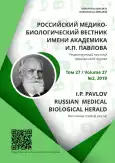Comparative efficiency of suturing of defect of kidney after resection with a mesh implant on pigs models
- Authors: Filimonov V.B.1, Vasin R.V.1, Sobennikov I.S.1, Petryaev A.V.2
-
Affiliations:
- Ryazan State Medical University
- Tula Regional Clinical Hospital
- Issue: Vol 27, No 2 (2019)
- Pages: 197-202
- Section: Original study
- URL: https://journals.rcsi.science/pavlovj/article/view/14539
- DOI: https://doi.org/10.23888/PAVLOVJ2019272197-202
- ID: 14539
Cite item
Abstract
Aim. Improvement of the quality of the kidney resection.
Materials and Methods. A total of 50 laparoscopic kidney resections were performed on pig models. In 25 cases, resection was carried out according to the standard method of hemostasis of the kidney resection bed using U-shaped hemostatic sutures vicryl 3-0. In 25 cases, the kidney resection bed was sutured according to the author's method of hemostasis of the kidney resection bed using a polypropylene mesh.
Results. The mean operative time was comparable in the comparison groups, intraoperative blood loss was 30% lower in the group of pig models operated on with a prolene implant. The mean weight ratio of the resected kidney to the contralateral kidney was 77.3% after the classic resection of kidney and 85.6% after the resection with use of a prolene implant.
Conclusion. Laparoscopic kidney resection using a mesh implant is a highly efficient method of kidney resection, providing high-quality hemostasis with less traumatization of healthy renal parenchyma. The proposed method is recommended for further study.
Keywords
Full Text
##article.viewOnOriginalSite##About the authors
Viktor B. Filimonov
Ryazan State Medical University
Email: vestnik@rzgmu.ru
ORCID iD: 0000-0002-2199-0715
SPIN-code: 7090-0428
ResearcherId: B-3403-2019
MD, PhD, Head of the Department of Urology and Nephrology
Russian Federation, RyazanRoman V. Vasin
Ryazan State Medical University
Email: vestnik@rzgmu.ru
ORCID iD: 0000-0002-0216-2375
SPIN-code: 2212-3872
ResearcherId: B-9913-2019
MD, PhD, Associate Professor of the Department of Urology and Nephrology
Russian Federation, RyazanIvan S. Sobennikov
Ryazan State Medical University
Author for correspondence.
Email: isobennikov@mail.ru
ORCID iD: 0000-0002-5967-6289
SPIN-code: 6103-2197
ResearcherId: B-7382-2019
MD, PhD, Assistant of the Department of Urology and Nephrology
Russian Federation, RyazanAlexandr V. Petryaev
Tula Regional Clinical Hospital
Email: vestnik@rzgmu.ru
ORCID iD: 0000-0002-3108-1312
SPIN-code: 2259-7779
ResearcherId: B-6892-2019
Head of the Department of Urology
Russian Federation, TulaReferences
- Ferlay F, Autier P, Boniol M, et al. Estimates of the cancer incidence and mortality in Europe in 2006. Annals of Oncology. 2007;18(3):581-92. doi:10. 1093/annonc/mdl498
- Keane Th, Gillatt D, Evans ChP, et al. Current and Future Trends in Treatment of Renal Cancer. European Urology. 2007;6(3):374-84. doi:10.1016/ j.eursup.2006.12.006
- Parkin DM, Bray F, Ferlay J, et al. Global Cancer Statistics, 2002. CA A Cancer Journal for Clinicians. 2005;55(2):74-108. doi:10. 3322/canjclin.55.2.74
- Alekseev BYa, Anzhiganova YuV, Lykov AV, et al. Some specific features of the diagnosis and treatment of kidney cancer in Russia: preliminary results of a multicenter cooperative study. Cancer Urology. 2012;(3):24-30. (In Russ).
- Chissov VI, Starinskiy VV, Petrova GV, editors. Zlokachestvennyye novoobrazovaniya v Rossii v 2010 godu (zabolevayemost’ i smertnost’). Mos-cow; 2011. (In Russ).
- Gulov MK, Abdulloev SM, Rofiev KhK. Quality of life in patients with chronic kidney disease. I.P. Pavlov Russian Medical Biological Herald. 2018; 26(4):493-9. (In Russ). doi: 10.23888/PAVLOVJ 2018264493-499









